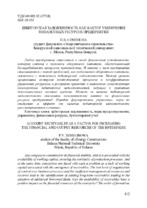| dc.contributor.author | Семёнова, П. В. | ru |
| dc.coverage.spatial | Минск | ru |
| dc.date.accessioned | 2019-12-03T12:08:35Z | |
| dc.date.available | 2019-12-03T12:08:35Z | |
| dc.date.issued | 2019 | |
| dc.identifier.citation | Семёнова, П. В. Дебиторская задолженность как фактор увеличения финансовых ресурсов предприятия = Account receivables as a factor for increasing the financial and output resources of the enterprise / П. В. Семёнова // Экономика строительного комплекса и городского хозяйства [Электронный ресурс] : материалы международной научно-практической конференции / редкол.: О. С. Голубова [и др.]. – Минск : БНТУ, 2019. – С. 112-115. | ru |
| dc.identifier.uri | https://rep.bntu.by/handle/data/61226 | |
| dc.description.abstract | Любое предприятие стремится к своей финансовой устойчивости, которая связана с наличием оборотного капитала, обеспечивающий бесперебойность процессов производства. И вместе с тем предприятия сталкиваются с такой проблемой, как недостаток оборотного капитала, связанного с появлением дебиторской задолженности. Низкий уровень организации контроля хозяйственных процессов и неэффективное управления ресурсами и резервами приводят к выявлению существующих долгосрочных дебиторских задолженностей, ведущих к принятию дополнительных заемных средств. Может ли наличие дебиторской задолженности оказывать положительное влияние на финансовые ресурсы предприятия? Порядок формирования, управление, меры по снижению и эффект от наличия дебиторской задолженности рассматриваются в статье. | ru |
| dc.language.iso | ru | ru |
| dc.publisher | БНТУ | ru |
| dc.title | Дебиторская задолженность как фактор увеличения финансовых ресурсов предприятия | ru |
| dc.title.alternative | Account receivables as a factor for increasing the financial and output resources of the enterprise | ru |
| dc.type | Working Paper | ru |
| local.description.annotation | Any company is committed to its financial stability, which is associated with the availability of working capital, ensuring the continuity of production processes. And at the same time, enterprises are faced with such a problem as a lack of working capital associated with the emergence of receivables. The low level of organization of control over business processes and the inefficient management of resources and reserves lead to the identification of existing long-term receivables leading to the adoption of additional borrowed funds. Can the availability of receivables have a positive impact on the financial resources of the enterprise? The order of formation, management, measures to reduce and the effect of receivables are discussed in the article. | ru |

